
The northern cardinal, known colloquially as the redbird, common cardinal, red cardinal, or just cardinal, is a bird in the genus Cardinalis. It can be found in southeastern Canada, through the eastern United States from Maine to Minnesota to Texas, New Mexico, southern Arizona, southern California, and south through Mexico, Belize, and Guatemala. It is also an introduced species in a few locations such as Bermuda and Hawaii. Its habitat includes woodlands, gardens, shrublands, and wetlands.

Anolis carolinensis or green anole is a tree-dwelling species of anole lizard native to the southeastern United States and introduced to islands in the Pacific and Caribbean. A small to medium-sized lizard, the green anole is a trunk-crown ecomorph and can change its color to several shades from brown to green.
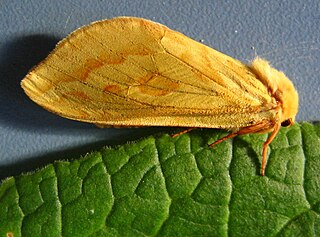
The ghost moth or ghost swift is a moth of the family Hepialidae. It is common throughout Europe, except for the far south-east.

Cancer pagurus, commonly known as the edible crab or brown crab, is a species of crab found in the North Sea, North Atlantic Ocean, and perhaps the Mediterranean Sea. It is a robust crab of a reddish-brown colour, having an oval carapace with a characteristic "pie crust" edge and black tips to the claws. A mature adult may have a carapace width up to 25 centimetres and weigh up to 3 kilograms. C. pagurus is a nocturnal predator, targeting a range of molluscs and crustaceans. It is the subject of the largest crab fishery in Western Europe, centred on the coasts of the British Isles, with more than 60,000 tonnes caught annually.
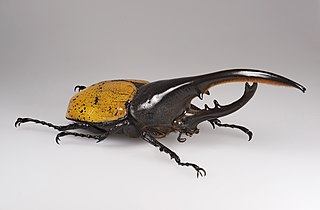
The Hercules beetle is a species of rhinoceros beetle native to the rainforests of southern Mexico, Central America, South America, and the Lesser Antilles. It is the longest extant species of beetle in the world, and is also one of the largest flying insects in the world.
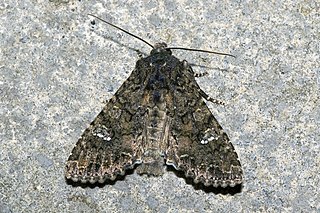
The cabbage moth is primarily known as a pest that is responsible for severe crop damage of a wide variety of plant species. The common name, cabbage moth, is a misnomer as the species feeds on many fruits, vegetables, and crops in the genus Brassica. Other notable host plants include tobacco, sunflower, and tomato, making this pest species particularly economically damaging.

Danaus chrysippus, also known as the plain tiger, African queen, or African monarch, is a medium-sized butterfly widespread in Asia, Australia and Africa. It belongs to the Danainae subfamily of the brush-footed butterfly family Nymphalidae. Danainae primarily consume plants in the genus Asclepias, more commonly called milkweed. Milkweed contains toxic compounds, cardenolides, which are often consumed and stored by many butterflies. Because of their emetic properties, the plain tiger is unpalatable to most predators. As a result, its colouration is widely mimicked by other species of butterflies. The plain tiger inhabits a wide variety of habitats, although it is less likely to thrive in jungle-like conditions and is most often found in drier, wide-open areas.
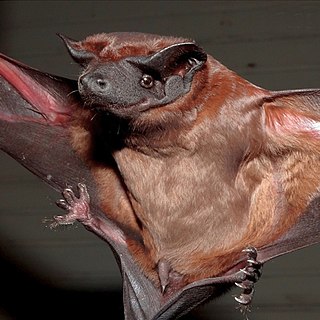
The cinnamon dog-faced bat, is a South American bat species of the family Molossidae. It is found in northern and central South America.

The brown greater galago, also known as the large-eared greater galago or thick-tailed galago, is a nocturnal primate, the largest in the family of galagos. As opposed to smaller galago species it would climb, walk or run rather than leap.

Boyd's forest dragon is a species of arboreal lizard in the family Agamidae. The species is native to rainforests and their margins in the Wet Tropics region of northern Queensland, Australia. It is the larger of the two species of Lophosaurus found in Australia. Another species, the southern angle-headed dragon, L. spinipes, is found in southern Queensland and northern New South Wales.

The yellow-throated frog, Trinidadian stream frog, or Trinidad poison frog is a diurnal species of frog in the family Aromobatidae that is endemic to the island of Trinidad in the Republic of Trinidad and Tobago. Trinidad poison frogs can be found in rocky streams in moist montane forests. The species has cryptic coloration and is sexually dimorphic. Mannophryne venezuelensis from the Paria Peninsula in Venezuela were also formerly included in this species. Currently this species is listed as of "Least Concern" on IUCN, but there is a general lack of understanding of its distribution. The frog experiences habitat loss. Both sexes are territorial and provide parental care together.

Ayres's hawk-eagle, also referred to as Ayres' eagle, is a medium-sized bird of prey in the family Accipitridae. It is native to African woodlands. Its name honors South African ornithologist Thomas Ayres.

The green monkey, also known as the sabaeus monkey, is an Old World monkey with golden-green fur and pale hands and feet. The tip of the tail is golden yellow as are the backs of the thighs and cheek whiskers. It does not have a distinguishing band of fur on the brow, like other Chlorocebus species, and males have a pale blue scrotum. Some authorities consider this and all of the members of the genus Chlorocebus to be a single widespread species, C. aethiops.
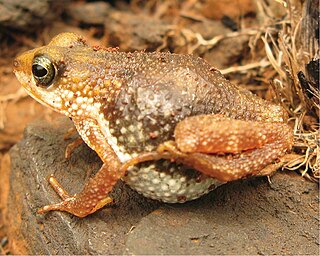
Nimbaphrynoides is a monotypic genus of true toads from highlands in the Mount Nimba region of the West African countries of Guinea, Liberia, and Côte d'Ivoire. The sole species is Nimbaphrynoides occidentalis. Along with Nectophrynoides, Eleutherodactylus jasperi, and Limnonectes larvaepartus, Nimbaphrynoides is one of the only anurans that combine internal fertilization with ovoviviparity.

Dryomyza anilis is a common fly from the family Dryomyzidae. The fly is found through various areas in the Northern hemisphere and has brown and orange coloration with distinctive large red eyes. The life span of the fly is not known, but laboratory-reared males can live 28–178 days. D. anilis has recently been placed back in the genus Dryomyza, of which it is the type species. Dryomyzidae were previously part of Sciomyzidae but are now considered a separate family with two subfamilies.

Cochliomyia macellaria, also known as the secondary screwworm, is a species of blow fly in the family Calliphoridae. These screwworms are referred to as "secondary" because they typically infest wounds after invasion by primary myiasis-causing flies. While blow flies may be found in every terrestrial habitat, C. macellaria is primarily found in the United States, American tropics, and sometimes southern Canada. They are most common in the southeastern United States in states like Florida. C. macellaria have a metallic greenish-blue thorax and a red-orange head and eyes. These adult blowflies range from 5–8 mm in size.
Illyria viridis, the yidiyidi, is a species of singing cicada found in Western Australia. The genus Illyria was created in 1985 by Australian entomologist Maxwell Sydney Moulds. The yidiyidi was first described by Moulds and David C. Marshall in 2022. Prior to 2022, the genus consisted of only four cicada species for almost forty years.

Cyrtolobus is a genus of treehoppers in the family Membracidae. There are more than 50 described species in Cyrtolobus, found in North and Central America.

Cyrtolobus tuberosus is a species of treehopper belonging to the genus Cyrtolobus. It was first described by Léon Fairmaire in 1846 as Thelia tuberosa.
Cyrtolobus fuscipennis is a species of treehopper belonging to the genus Cyrtolobus. It was first described by the American entomologist Edward Payson Van Duzee in 1908.


















